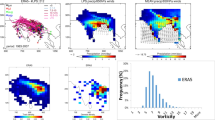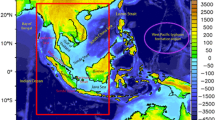Abstract
A regional coupled atmosphere–ocean model was developed to study the role of air–sea interactions in the simulation of the Indian summer monsoon. The coupled model includes the regional climate model (RegCM3) as atmospheric component and the regional ocean modeling system (ROMS) as oceanic component. The two-way coupled model system exchanges sea surface temperature (SST) from the ocean to the atmospheric model and surface wind stress and energy fluxes from the atmosphere to the ocean model. The coupled model is run for four years 1997, 1998, 2002 and 2003 and the results are compared with observations and atmosphere-only model runs employing Reynolds SSTs as lower boundary condition. It is found that the coupled model captures the main features of the Indian monsoon and simulates a substantially more realistic spatial and temporal distribution of monsoon rainfall compared to the uncoupled atmosphere-only model. The intraseasonal oscillations are also better simulated in the coupled model compared to the atmosphere-only model. These improvements are due to a better representation of the feedbacks between the SST and convection and highlight the importance of air–sea coupling in the simulation of the Indian monsoon.
















Similar content being viewed by others
References
Bhaskaran B, Jones RG, Murphy JM, Noguer M (1996) Simulations of the Indian summer monsoon using a nested climate model: domain size experiments. Clim Dyn 12:573–587
Bonjean F, Lagerloef GSE (2002) Diagnostic model and analysis of the surface currents in the tropical Pacific Ocean. J Phys Oceanogr 32:2938–2954
Dash SK, Shekhar MS, Singh GP (2006) Simulation of Indian summer monsoon circulation and rainfall using RegCM3. Theor Appl Climatol 86:161–172
Dickinson RE, Henderson-Sellers A, Kennedy PJ (1993) Biosphere-atmosphere transfer scheme (BATS) verson 1E as coupled to the NCAR Community Climate Model. NCAR Technical Note NCAR/TN–387 + STR, 72 p
Fasullo J (2005) Atmospheric hydrology of the anomalous 2002 Indian summer monsoon. Mon Weather Rev 133:2996–3014
Fu X, Wang B, Li T (2002) Impacts of air–sea coupling on the simulation of mean Asian summer monsoon in the ECHAM4 model. Mon Weather Rev 130:2889–2904
Fu X, Wang B, Waliser DE, Tao L (2007) Impact of atmosphere–ocean coupling on the predictability of monsoon intraseasonal oscillations. J Atmos Sci 64:157–174
Giorgi F, Mearns LO (1999) Introduction to special section. Regional climate modeling revisited. J Geophys Res 104:6335–6352
Giorgi F, Bi X (2000) A study of internal variability of a regional climate model. J Geophys Res 105:29503–29521
Giorgi F, Marinucci MR, Bates GT (1993a) Development of a second generation regional climate model (RegCM2). Part I: Boundary layer and radiative transfer processes. Mon Weather Rev 121:2794–2813
Giorgi F, Marinucci MR, Bates GT, DeCanio G (1993b) Development of a second generation regional climate model (RegCM2). Part II: Convective processes and assimilation of lateral boundary conditions. Mon Weather Rev 121:2814–2832
Giorgi F, Huang Y, Nishizawa K, Fu C (1999) A seasonal cycle simulation over eastern Asia and its sensitivity to radiative transfer and surface processes. J Geophys Res 104:6403–6423
Giorgi F et al (2006) Introduction to the TAC Special Issue. The RegCNET network. Theor Appl Clim 86:1–4
Goswami BN, Ajaya M (2001) Intraseasonal oscillations and interannual variability of the Indian summer monsoon. J Clim 14:1180–1198
Grell GA (1993) Prognostic evaluation of assumption used by cumulus parameterization. Mon Weather Rev 121:754–787
Holtslag AAM, De Bruijn EIF, Pan HL (1990) A high resolution air mass transformation model for short-range weather forecasting. Mon Weather Rev 118:1561–1575
Ji Y, Vernekar AD (1997) Simulation of the Asian summer monsoons of 1987 and 1988 with a regional model nested in a global GCM. J Clim 10:1965–1979
Jones PW (1999) First- and second-order conservative remapping schemes for grids in spherical coordinates. Mon Weather Rev 127:2204–2210
Juang H-MH, Hong S-Y, Kanamitsu M (1997) The NCEP regional spectral model: an update. Bull Am Meteor Soc 78:2125–2143
Jacob D, Podzum R (1997) Sensitivity studies with the regional climate model REMO. Meteor Atmos Phys 63:119–129
Kalnay E et al (1996) The NCEP/NCAR 40-year reanalysis project. Bull Am Meteor Soc 77:437–472
Kemball-cook S, Wang B, Fu X (2002) Simulation of the intraseasonal oscillation in the ECHAM-4 model: the impact of coupling with an ocean model. J Atmos Sci 59:1433–1453
Kiehl, JT, Hack JJ, Bonan GB, Boville BA, Breigleb BP, Williamson D, Rasch P (1996) Description of the NCAR community climate model (ccm3). Technical report NCAR/TN-430 + STR, National Center for Atmospheric Research
Krishna Kumar K, Hoerling M, Rajagopalan B (2005) Advancing dynamical prediction of Indian monsoon rainfall. Geophys Res Lett 32:L0874. doi:10.1029/2004GL021979
Monterey GI, Levitus S (1997) Climatological cycle of mixed layer depth in the world ocean. US Government Printing Office, NOAA NESDIS, 5 p
Mesinger F, Black TL (1992) On the impact on forecast accuracy of the step-mountain (eta) vs. sigma coordinate. Meteor Atmos Phys 50:47–60
Pal JS et al (2007) Regional climate modelling for the developing world: The ICTP RegCM3 and RegCNET. Bull Am Meteor Soc 88:1395–1409
Parthasarathy B, Munot AA, Kothawale DR (1994) All India monthly and seasonal rainfall series, 1871–1993. Theor Appl Climatol 49:217–224
Rajeevan M, Bhate J, Kale JD, Lal B (2006) High resolution daily gridded rainfall data for the Indian region: analysis of break and active monsoon spells. Curr Sci 91:296–306
Rajendran K, Kitoh A (2006) Modulation of tropical intraseasonal oscillations by ocean–atmosphere coupling. J Clim 19:366–391
Ratnam JV, Kumar KK (2005) Sensitivity of the simulated monsoons of 1987 and 1988 to convective parameterization schemes in MM5. J Clim 18:2724–2743
Ren X, Qian Y (2005) A coupled regional air-sea model, its performance and climate drift in simulation of the East Asian summer monsoon in 1998. Int J Climatol 25:679–692
Reynolds RW, Smith TM (1994) Improved global sea surface temperature analysis using optimum interpolation. J Clim 7:929–948
Rummukainen M, Raisanen J, Bringfelt B, Ullerstig A, Onstedt A, Willen U, Hansson U, Jones C (2001) A regional climate model for northern Europe: model description and results from the downscaling of two GCM control simulations. Clim Dyn 17:339–359
Seo K-H et al (2007) The Boreal summer intraseasonal oscillation simulated in the NCEP climate forecast system: the effect of sea surface temperature. Mon Weather Rev 135:1807–1827
Shchepetkin AF, McWilliams JC (2005) The regional ocean modeling system: a split-explicit, free-surface, topography following coordinates ocean model. Ocean Model 9:347–404
Sikka DR, Gadgil S (1980) On the maximum cloud zone and the ITCZ over Indian longitudes during the southwest monsoon. Mon Weather Rev 108:1840–1853
Song Y, Semazzi FHM, Xie L, Ogallo LJ (2004) A couplet regional climate model for the Lake Victoria basin of East Africa. Int J Climatol 24:57–75
Srivastava AK, Rajeevan M, Kshirsagar SR (2004) Role of the ITCZ over the North Indian Ocean and Pre-Mei-Yu front in modulating july rainfall over India. J Clim 17:673–678
Vernekar AD, Ji Y (1999) Simulation of the onset and intraseasonal variability of two contrasting summer monsoons. J Clim 12:1707–1725
Wang B, Kang I-S, Lee J-Y (2004) Ensemble simulations of Asian–Australian monsoon variability by 11 AGCMs. J Clim 17:803–818
Wang B, Ding Q, Fu X, Kang I-S, Jin K, Shukla J, Doblas-Reyes F (2005) Fundamental challenge in simulation and prediction of summer monsoon rainfall. Geophys Res Lett 32:L15711. doi:10.1029/2005GL022734
Xie P, Arkin P (1997) Global precipitation: a 17 year monthly precipitation based on observations, satellite estimates, and numerical model outputs. Bull Am Meteor Soc 78:2539–2558
Xie SP, Miyama T, Wang Y, Xu H, Simon P, Justin R, Richards KJ, Mochizuki T, Awaji T (2007) A regional ocean-atmosphere model for eastern Pacific climate: towards reducing tropical biases. J Clim 20:1504–1522
Zeng X, Zhao M, Dickinson RE (1998) Intercomparison of bulk aerodynamic algorithms for computation of sea surface fluxes using TOGA COARE and TAO data. J Clim 11:2628–2644
Acknowledgments
This work was carried out under the EuIndia grid project. The first author visited the International Center for Theoretical Physics (ICTP), Trieste, Italy during the project. He wishes to acknowledge the management of Center for Development of Advanced Computing, Pune, India and ICTP for the encouragement and support. EuIndia gird project is funded by the European Union. The authors wish to thank the agency for funding the research. The NCEP-NCAR Reanalysis data, the Reynolds Sea surface temperature and Xie–Arkin precipitation data were all obtained from NOAA-CIRES Climate Diagnostics Center, Boulder, Colorado, USA, through their Web site at http://www.cdc.noaa.gov/. The authors wish to thank Climate Diagnostic Center for the data. The surface currents data was downloaded from the site http://www.oscar.noaa.gov/.
Author information
Authors and Affiliations
Corresponding author
Rights and permissions
About this article
Cite this article
Ratnam, J.V., Giorgi, F., Kaginalkar, A. et al. Simulation of the Indian monsoon using the RegCM3–ROMS regional coupled model. Clim Dyn 33, 119–139 (2009). https://doi.org/10.1007/s00382-008-0433-3
Received:
Accepted:
Published:
Issue Date:
DOI: https://doi.org/10.1007/s00382-008-0433-3




